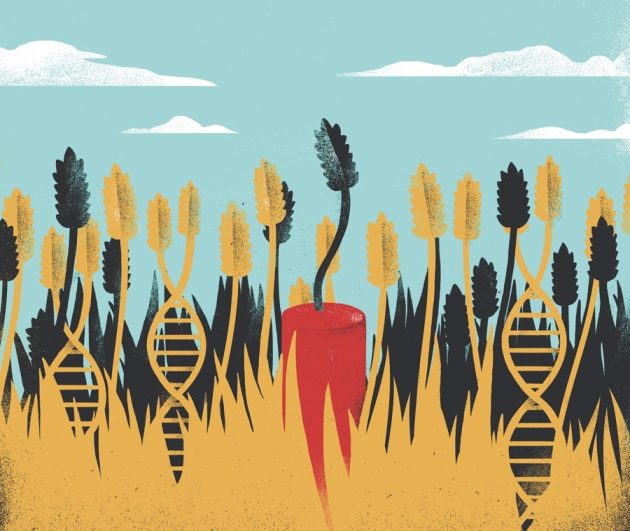A new report issued by the National Academy of Sciences says U.S. regulatory agencies need to prepare for new plants, animals, and microbes that will be hitting the market in the next five to 10 years. The new products, the report says, could overwhelm regulatory agencies like the U.S. Department of Agriculture and Food and Drug Administration.
"All of these products have the potential to be beneficial, but the question to me is, how do they compare to the alternative?" says Jennifer Kuzma, co-director of the Genetic Engineering and Society Center at North Carolina State University and a member of the National Academy of Sciences committee that prepared the report.
Here are some products scientists are already working on that U.S. regulatory agencies aren't ready for.
Living bacteria that act like drugs. Changes in the vast communities of micro-organisms that live in and outside the human body may contribute to diseases, but scientists don't yet understand all these complex relationships. That isn't stopping companies trying to develop genetically engineered bacteria to treat a whole range of medical conditions, from cancer to metabolic disease. Ingested in pills, these living micro-organisms could end up in wastewater and possibly drinking water. The U.S. Environmental Protection Agency might have to get involved.
Gene-edited animals and crops. Early this year, the FDA proposed new regulations requiring researchers to get approval for gene editing in cattle, pigs, dogs, and other animals. The FDA already regulates transgenic animals—those with DNA added from a different species, like genetically modified salmon. The proposed guidelines mean each alteration to an animal's own genome would be subject to approval.
Meanwhile, traditional genetically engineered crops are currently overseen by the USDA. Creating these crops usually involves inserting genes from other species. But so far, gene-edited foods haven't been subject to regulation because they don't contain foreign DNA. For example, Cellectis, an immunotherapy company that hosted the first gene-edited dinner, is tweaking existing genes so that plants will provide more nutritional value, stay fresh longer, and resist disease. Meanwhile, DuPont Pioneer is using CRISPR to make corn more resistant to drought.
Comment: Monsanto licenses CRISPR technology to modify crops
The US Department of Agriculture has said that because the technique does not insert a foreign gene into plants, but either deletes or modifies an existing one, CRISPR'd crops (such as a mushroom that doesn't turn brown when cut, or drought-tolerant corn being developed by DuPont Pioneer) do not need regulatory approval as GMOs do.
Lab-grown meat. This week, startup Memphis Meats announced plans to start selling chicken grown from cultured animal cells beginning in 2021. The company is among a handful of startups aiming to develop animal-like proteins that don't require traditional agricultural methods. Lab-grown meat represents a more environmentally and ethically friendly way to produce food, but it's unclear how these products would be regulated. The U.S. Department of Agriculture controls real meat, dairy, and eggs, while the FDA monitors food additives and products made from human cells. Lab-made meat falls into a regulatory gray area, and there's no precedent for approving these products.
Fragrant moss. Beyond products that are more nutritious or better for the environment, plants that appeal to consumers, perhaps for their aesthetics or novelty, are also likely to become more common, according to the National Academies report. This includes fragrant moss, flowers that are always in bloom, and glowing plants. Since these genetically engineered plants don't pose a pathogen risk, no regulatory approval is currently required in the U.S. But one worry is that these plants could have potentially harmful effects on natural wildlife if they end up outside a person's home.
Gene drives. A powerful technique that promotes an engineered gene's spread through an entire population is being considered to eliminate invasive rodents on islands and to wipe out mosquitoes that transmit malaria. The idea is that organisms would inherit self-limiting genes that drive them toward extinction. It could be a powerful tool to help save threatened wildlife or reduce disease. But a gene drive has never been tried in the wild. Because of the possibility of unintended consequences for a local community, the National Academies report suggests that an external review committee of experts, as well as members of the public, sign off on a gene drive before it could be used. Kuzma says the technology might get the green light in a situation where there are no other options, like a vaccine or effective therapy.
About the author
Emily Mullin MIT Technology Review's associate editor for biomedicine, reporting from Washington, D.C. I look for stories about how biotechnology and innovations in medicine are changing our health and livelihoods—and at what cost. I am also interested in the degree to which these advances affect health equity around the world. Previously, I was a contributor at Forbes and an associate editor at FierceBiotech. Get in touch at emily.mullin@technologyreview.com.




Comment: God's red pencil? CRISPR and the myths of precise genome editing